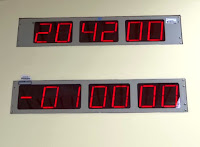All time of the chronology below are local/Kourou time (i.e. Universal Time -3 hours)
The launch window starts today 15/07/2015 at H0 18:42
Duration of the Launch window: 37 minutes,
Launch windows ends at 19:19.
07:10 am: Arriving at S1 B (few kilometers from the launch pad). An overview of the the weather over the place this morning: wet and cloudy, no rain and light breeze.
07:30 @ EPCU S1B LBC2. The D-Day has started. Arrival of the teams.
View on LBC 2 (satellite control room) just before the arrival of the teams
08:39 am (H0-10h03m) ; Start of the Countdown in Jupiter
09:40 am (H0-9h02m): MSG-4 is authorised to be switched on
In the meantime we got a visitor to support us in the LBC2...perched next to Jean-Claude, the RPS (Spacecraft Preparation Manager).
Toco, MSG-4 mascot
10:07 am (H0-08h35m): the RPS is asked to test Spacecraft RED status (Green back 10 minutes later)...
11:27 am (H0-07h15m): MSG-4 Status for meteo debrief: MSG status is green. S/C is ON. Temperatures are OK.
12:01 (H0-06h41m): Meteo is GREEN (in particular high altitude wind are OK)
12:12 (H0-06h30m ): MSG-4 RF transmitter in ON. Below, Gérard in front of the RF bays. Telemetry received by ESOC via NDIU.
13:11 (H0-05h31m): All parameters in Jupiter 2 are GREEN.
13:30 (H0-05h12): Meteo is confirmed GREEN (no requirement anymore for EOLE plan. Launch attempt targeted for H0)
13:58 (H0-04h44m): All parameters GREEN
in the meantime, there is evidence from the wall monitors in S1B giving live views from the launch pad, that the cryogenic fueling of the launcher has started.
15:37 (H0-03h05m): Status of the MSG-4 Spacecraft is GREEN
15:45 (H0-02h57m): View on the launcher on the ELA-3 (from wall monitor).
16:42 (H0-02h00m): Status of the MSG-4 Spacecraft is GREEN. All parameters in Jupiter 2 are GREEN.
17:17 (H0-01h25m): Status of the MSG-4 Spacecraft is GREEN.
17:42 (H0-01h00m): Status of the MSG-4 Spacecraft is GREEN. Meteo is confirmed GREEN. Below a quick look on the LBC-2 clocks: the first line UT and second line count down.Still one hour to go!, We get closer.
LBC-2 clocks
18:10 (H0-32m00s): Status of the MSG-4 Spacecraft is GREEN.
18:20 (H0-22m00s): MSG can go on internal power.
18:31 (H0-11m00s) MSG on internal Power and Status of the MSG-4 Spacecraft is GREEN. Meteo is GREEN.
18:35 (H0-07m00s): Start of the synchronized sequence.
18:42 (H0) and lift-off.
19:22 (H0+40m22s): MSG-4 Separation. Mission is declared successful!
Separation from the launcher...Bye Bye MSG-4!
Credits: Arianespace
It is time now to celebrate in LBC-2.
And now the LEOP team in ESOC (Darmstadt) will take over... All the best from Kourou!


























